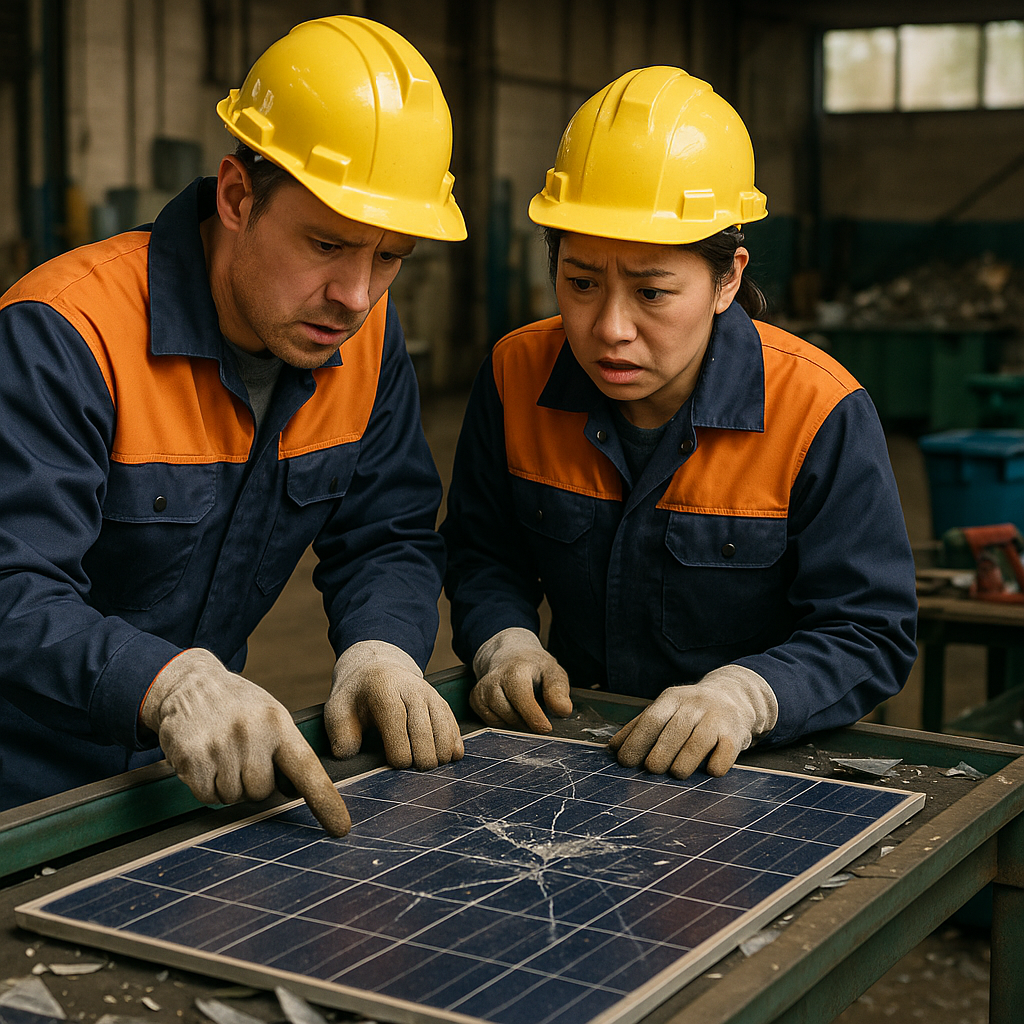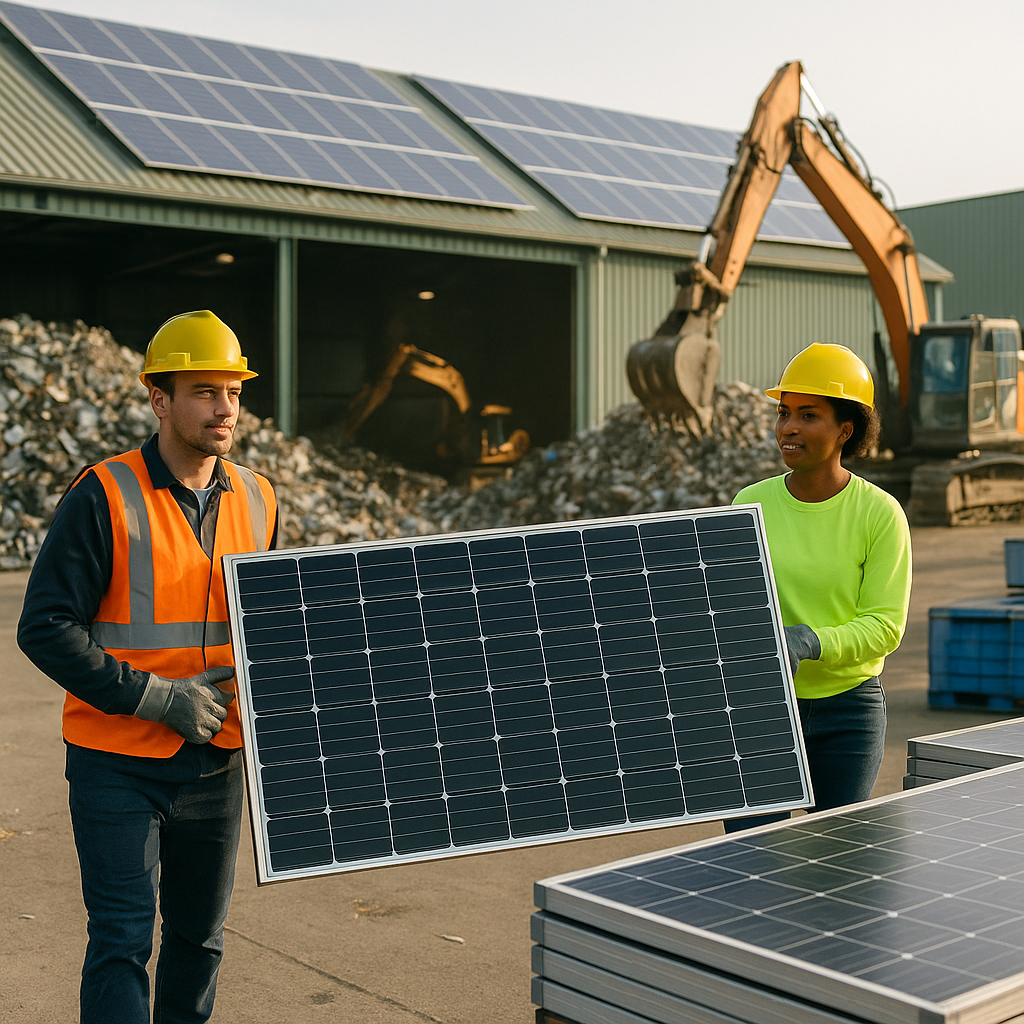5901 Botham Jean Blvd, Dallas, TX 75215
The Growing Need for Solar Panel Disposal Regulations
August 17, 2025Solar energy has evolved from being an alternative power source to becoming a mainstream electricity solution. In 2020 alone, solar panels contributed approximately 40% of new U.S. electric generation capacity, a significant increase from just 4% a decade earlier. This rapid adoption signifies substantial environmental progress. However, as these panels reach the end of their 25-30 year lifespans, a new environmental challenge arises: the fate of millions of decommissioned solar panels.
The magnitude of this challenge is significant. By 2030, the United States will need to manage around one million tons of solar panel waste. This number is expected to grow to 10 million tons by 2050, making the U.S. the second-largest producer of solar panel waste globally. Currently, only about 10% of decommissioned panels are properly recycled, despite containing valuable materials like silver, silicon, and aluminum.
These panels are not just waste products. Many contain potentially hazardous materials such as lead and cadmium, which can leach into soil and groundwater if improperly disposed of in landfills. Despite these concerns, comprehensive federal regulations specifically addressing solar panel disposal are limited. The Environmental Protection Agency classifies end-of-life solar panels as electronic waste under the Resource Conservation and Recovery Act. However, this framework lacks specialized provisions for the unique challenges solar waste presents.
What are the Current Federal Regulations for Solar Panel Disposal?

Currently, there are no specific federal regulations exclusively for solar panel recycling in the United States. Instead, solar panel disposal falls under broader waste management regulations. The primary federal law guiding solar panel disposal is the Resource Conservation and Recovery Act (RCRA), providing the general framework for handling these materials at end-of-life.
When solar panels reach the end of their useful life and are removed from service, they become solid waste regulated under RCRA Subtitle D. The subsequent regulatory steps depend on the panel’s composition, as not all solar panels are treated identically from a regulatory perspective.
Hazardous Waste Classification
Solar panels are classified as hazardous waste under RCRA if they contain certain levels of toxic metals. The classification is determined by the Toxicity Characteristic Leaching Procedure (TCLP) test, which simulates leaching conditions in a landfill.
Testing shows variation in results, even among panels from the same manufacturer and model. Some panels pass toxicity tests while others fail, challenging waste generators in determining the proper disposal method.
- Heavy metals like lead and cadmium are the primary concerns, posing risks to human health and the environment.
- If metals leach at concentrations exceeding regulatory limits, the panels must be managed as hazardous waste.
- Thin-film solar panels containing cadmium telluride (CdTe) are more likely classified as hazardous waste compared to standard crystalline silicon panels.
- Generators determine hazardous waste status through testing or material knowledge.
Regulatory Exclusions for Recycling
Hazardous waste solar panels that are recycled may qualify for regulatory exclusions under RCRA. These include the transfer-based exclusion in states adopting recent Definition of Solid Waste Rules.
This conditional exclusion encourages recycling by third parties while offering a regulatory framework to prevent mismanagement. To qualify, solar panels must meet specific regulatory criteria.
Upcoming Universal Waste Regulations
On October 23, 2023, the EPA announced a regulatory update affecting solar panel disposal. The agency plans to propose a rule adding solar panels to the universal waste regulations under 40 CFR Part 273.
This proposed change would simplify management requirements for hazardous waste solar panels. The streamlined universal waste regulations aim to:
- Promote the collection and recycling of solar panels
- Encourage municipal and commercial recycling program development
- Reduce waste in municipal solid waste landfills
- Maintain appropriate environmental protections
The EPA is developing this rule partly in response to a petition by industry associations to classify solar panels as universal waste. A Notice of Proposed Rulemaking is expected in 2025.
State-Level Solar Panel Regulations
In the absence of specific federal regulations for solar panel recycling, several states have established their own policies:
- California and Hawaii classify hazardous waste solar panels as universal waste under state programs
- Washington has a Photovoltaic Module Stewardship and Takeback Program
- North Carolina has a regulatory program for renewable energy equipment management and decommissioning
- New Jersey has created a Solar Panel Recycling Commission
Until the proposed universal waste regulations are finalized, solar panel waste generators must determine if their panels qualify as hazardous waste under existing RCRA regulations and manage them accordingly.
How Do State-Level Solar Panel Disposal Policies Vary?
As solar energy adoption accelerates across America, states are developing diverse approaches to manage end-of-life solar panels. The regulatory landscape varies significantly from state to state, with some implementing comprehensive programs while others are still in the research phase. This patchwork of policies creates both challenges and opportunities for sustainable solar panel management.
Washington state leads the nation with its Photovoltaic Module Stewardship and Takeback Program. Enacted in 2017, this pioneering legislation requires manufacturers to finance and implement takeback and recycling programs for solar panels sold after July 1, 2017, at no cost to end users. As of July 1, 2023, manufacturers, distributors, retailers, and installers cannot sell panels in Washington without an approved stewardship plan. This manufacturer-funded approach ensures responsible end-of-life management while complementing Washington’s broader sustainability goals.
California adopts a different regulatory path by classifying end-of-life solar panels as Universal Waste. Under regulations enacted in 2020, panels with hazardous waste characteristics can be managed under less stringent handling requirements than fully regulated hazardous waste. While this classification reduces some regulatory burdens, it creates other constraints. Notably, California prohibits recyclers from using heat or chemical treatment processes commonly employed in solar panel recycling. The state’s approach aims to prevent panel abandonment but poses challenges for developing cost-effective recycling infrastructure.
Other states are exploring policy options through formal study commissions. North Carolina’s Department of Environmental Quality conducted a comprehensive investigation into solar panel management, submitting their findings in January 2021. Their research estimated 8.5 million panels will require decommissioning between 2036-2040, and established a management preference hierarchy: direct reuse first, followed by refurbishment, recycling, and disposal as the last resort. The commission also anticipated future rulemaking to classify solar panels as universal waste.
Similarly, New Jersey created a Solar Panel Recycling Commission in 2019 to investigate options and develop recommendations for legislative or administrative action. The nine-member commission includes representatives from government agencies, recycling experts, and solar industry stakeholders. New Jersey’s approach demonstrates how states can leverage diverse expertise to inform policy development.
Several states are in even earlier stages of policy consideration. Hawaii and Rhode Island have proposed legislation to study solar panel disposal and recycling options, while Illinois and Minnesota have formed stakeholder working groups to examine the issue. These initiatives reflect the growing recognition of the need for proactive planning as installed solar capacity continues to increase.
The variations in state approaches reflect different priorities, existing waste management frameworks, and solar market maturity. States with extensive solar installations are generally moving faster to implement policies, while those with emerging markets focus on research and planning. As the volume of decommissioned panels grows nationwide, more states will likely continue policy development.
These varying state-level policies create opportunities for innovative approaches to solar panel management, but also present challenges for manufacturers and recycling companies operating across multiple states. A more harmonized regulatory approach could streamline recycling efforts while maintaining appropriate environmental protections. Until then, stakeholders must navigate the complex and evolving policy landscape to ensure the sustainable management of end-of-life solar panels.
What are the Challenges in Implementing Solar Panel Recycling?

As solar energy installations rapidly expand worldwide, recycling photovoltaic (PV) panels at their end-of-life stage encounters significant hurdles. Current projections indicate a worrying accumulation of PV waste, expected to reach 1.7 million tons by the early 2030s and potentially 60-78 million tons by 2050. This impending waste crisis demands urgent attention to several critical recycling challenges.
Technical Complexity of Panel Composition
Solar panels are composed of multiple layers of materials bonded together for durability, making separation extremely challenging. Their complex composition includes glass, aluminum frames, silicon cells, copper wiring, silver contacts, and plastic components. This multi-material design presents a substantial technical barrier to efficient recycling.
Standard recycling techniques, such as shredding and thermal processing, can recover basic materials but struggle with complete separation. Most e-waste facilities primarily salvage aluminum frames and glass, representing the bulk of panel weight but not the most valuable components. The remaining materials often end up in landfills.
Advanced processes to extract valuable materials like silver and silicon require specialized technologies that aren’t widely available. Recent innovations show promise, with salt-etching approaches capable of recovering over 99% of silver and 98% of silicon, but these methods remain largely experimental rather than implemented on an industrial scale.
Economic Barriers to Viable Recycling
The economics of solar panel recycling pose significant challenges. The cost of recycling usually surpasses the value of recovered materials, leading to fundamental viability issues. In Europe, recycling costs range from €100 to €200 per ton, making landfill disposal the cheaper option for most waste handlers.
Several factors contribute to this economic challenge:
- High labor costs for manual disassembly of panels
- Transportation expenses to dedicated recycling facilities
- Energy-intensive processing required for material separation
- Lack of standardization across panel designs, necessitating different approaches
- Limited markets for some recovered materials
Without financial incentives or regulatory mandates, most decommissioned panels are likely to continue heading towards landfill disposal, the path of least resistance.
Infrastructure and Capacity Limitations
The infrastructure for global solar panel recycling is currently inadequate. Despite growing awareness, dedicated recycling facilities are scarce and typically operate at small scales. In the European Union, which has proactive regulations, the combined recycling capacity of around 40,000 tons annually is less than a third of the current waste volume of panels.
Collection logistics present another challenge. Unlike household recyclables, solar panels are dispersed across numerous sites, from residential rooftops to utility-scale solar farms, complicating collection and making it difficult to achieve economies of scale necessary for cost-effective recycling.
The lack of standardized processes hinders capacity development. Different panel types require specific recycling approaches, and variations in designs from manufacturers complicate the development of streamlined industrial processes. Many recyclers must invest in customized processes for each panel type, reducing economies of scale.
Environmental and Health Risks
Improper handling of solar panel waste poses environmental hazards, undermining the sustainability benefits of solar energy. Some panels contain toxic materials, including lead, cadmium, and other heavy metals, which can leach into soil and groundwater when panels degrade in landfills.
Workers involved in panel disassembly face exposure risks if proper safety protocols are not followed. Certain recycling processes can also generate hazardous byproducts or emissions if not properly controlled. These environmental and health concerns add complexity and cost to responsible recycling operations.
Regulatory Gaps and Inconsistencies
The regulatory landscape for solar panel recycling varies dramatically worldwide, creating inconsistent approaches and enforcement. While the European Union has implemented the Waste Electrical and Electronic Equipment (WEEE) Directive that covers PV panels, many regions have no specific regulations governing panel disposal.
This regulatory inconsistency results in several issues:
- Lack of standardized collection and recycling requirements
- Limited producer responsibility for end-of-life management
- Few incentives to design panels for easier recycling
- Minimal investment in recycling infrastructure
- Low awareness among consumers and installers about proper disposal
Without stronger and more consistent regulations, including extended producer responsibility frameworks, the solar industry lacks sufficient motivation to solve these recycling challenges.
As solar installations continue to accelerate globally, addressing these technical, economic, infrastructural, environmental, and regulatory barriers becomes increasingly urgent. Developing more efficient recycling technologies, combined with supportive policies and business models, will be essential to transform solar panel recycling from an environmental liability into an opportunity for resource recovery and sustainable materials management.
Conclusion: The Path Forward for Sustainable Solar Panel Disposal

As the solar industry grows rapidly, the fate of panels at the end of their lifecycle becomes increasingly critical. The solar waste management challenge encompasses environmental concerns and economic opportunities. With projections showing millions of tons of solar panel waste by 2050, establishing comprehensive and uniform disposal regulations is essential.
Recycling infrastructure for solar panels is advancing, with technologies now able to recover up to 95% of materials from end-of-life panels. These innovations help prevent harmful substances from entering landfills and recover valuable resources like glass, aluminum, silicon, and precious metals. This circular approach reduces the need for raw material extraction and fosters new economic opportunities in the recycling sector. For your recycling needs, contact Okon Recycling at 214-717-4083.
